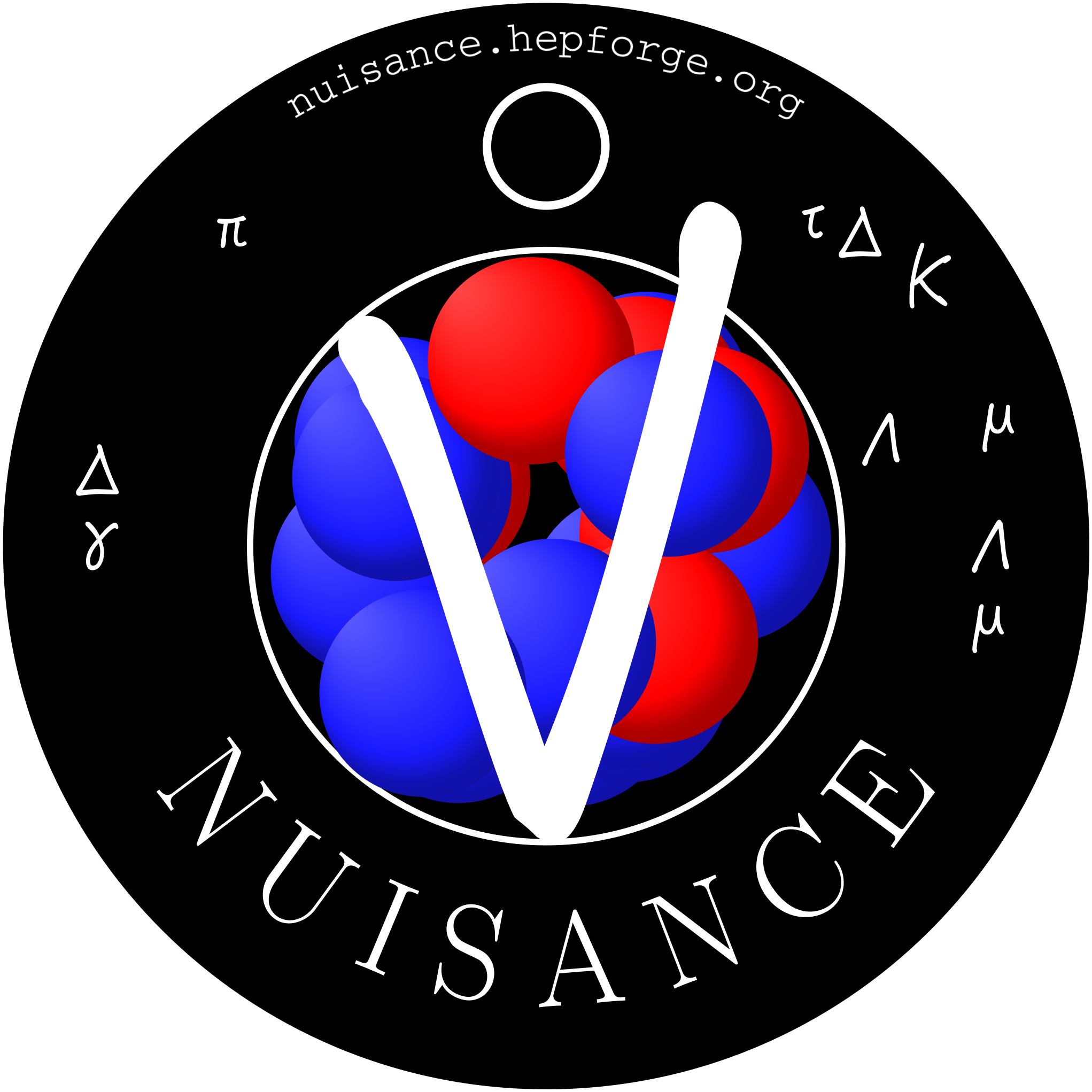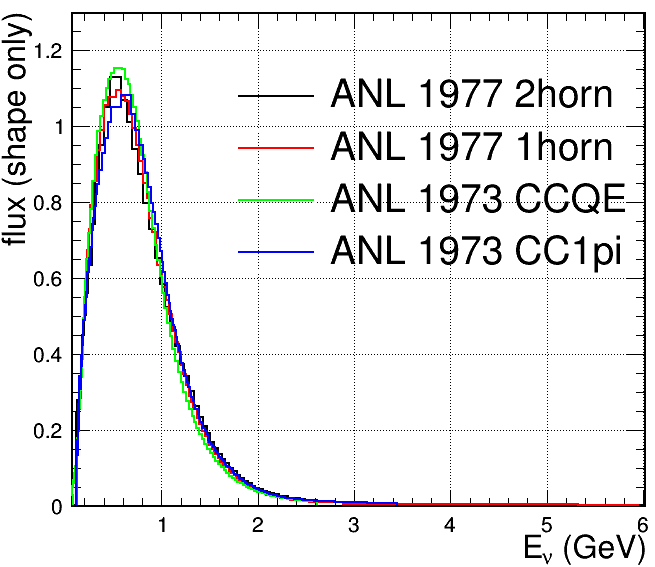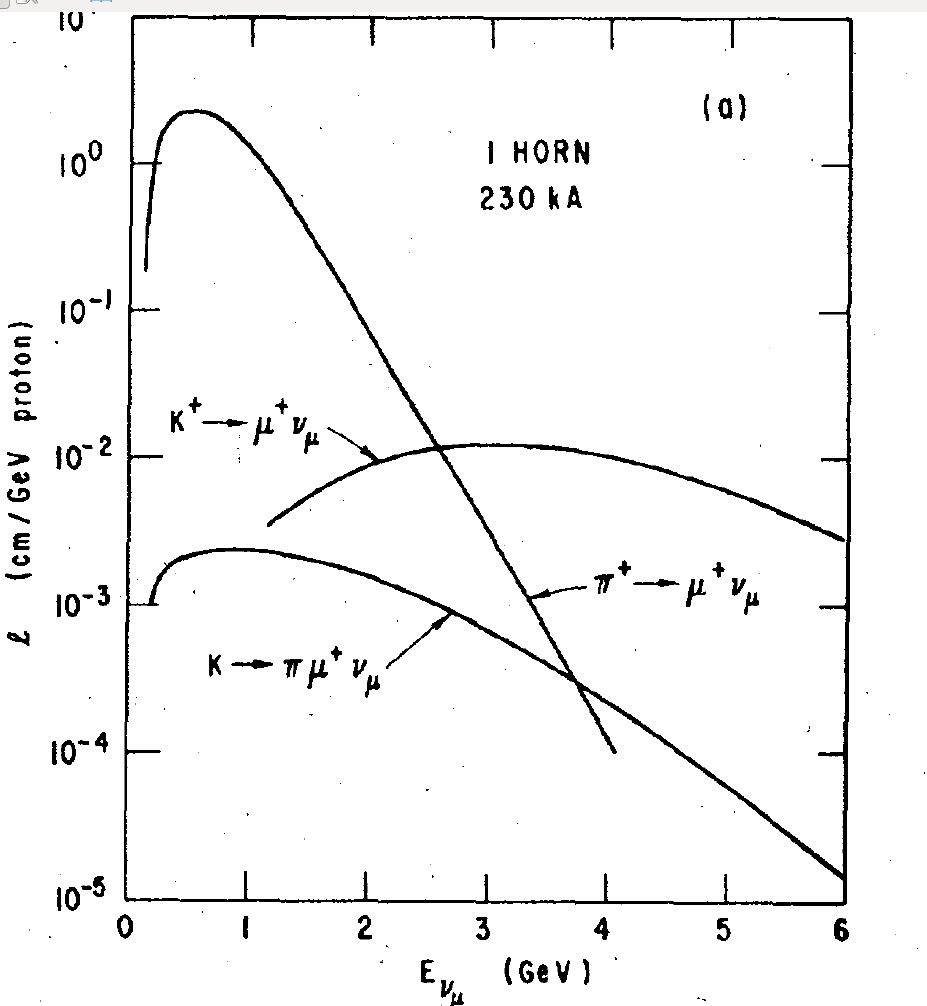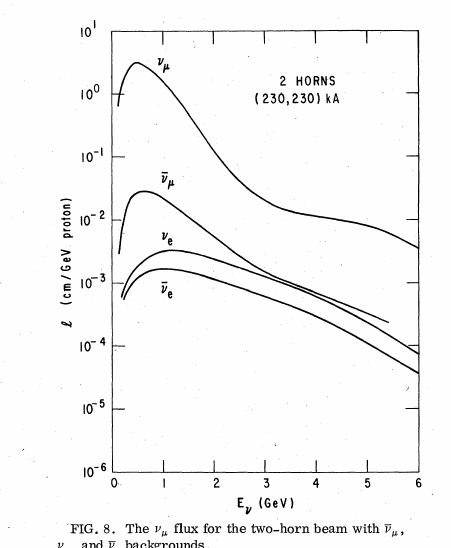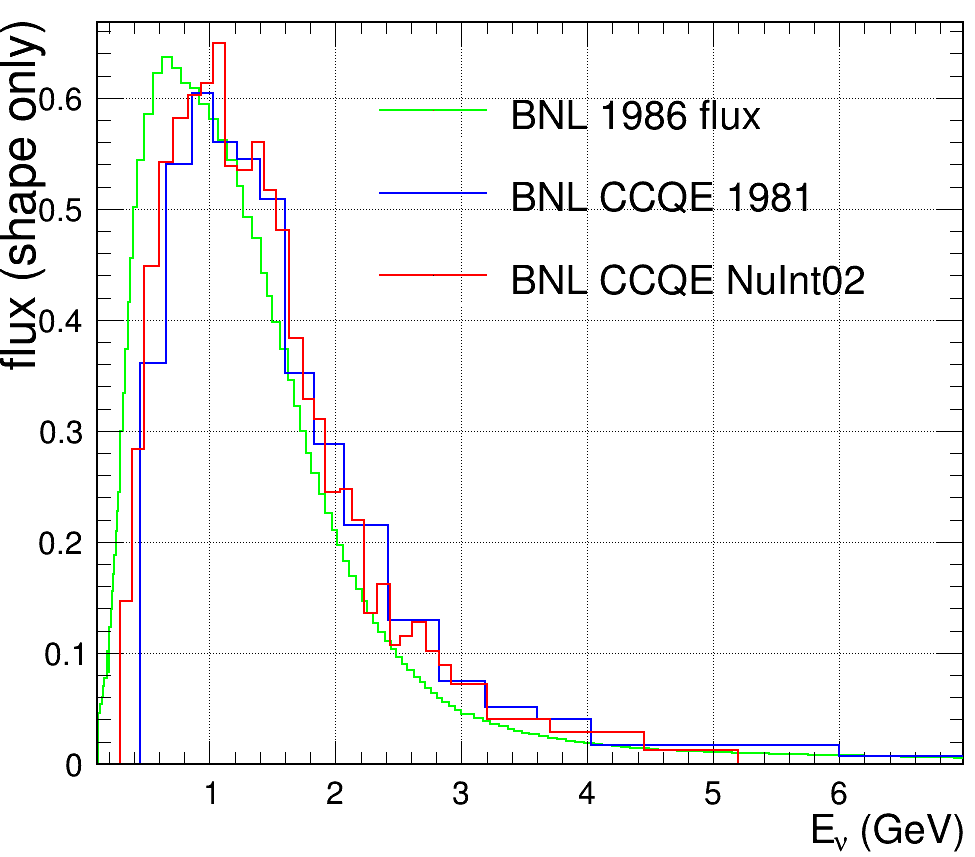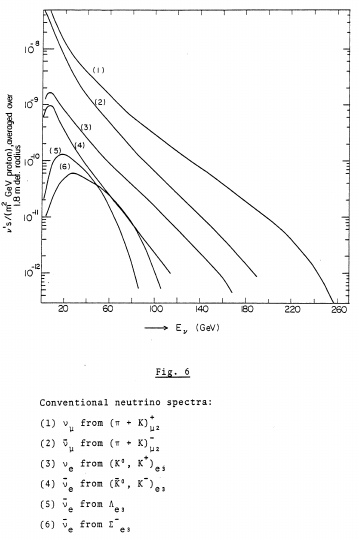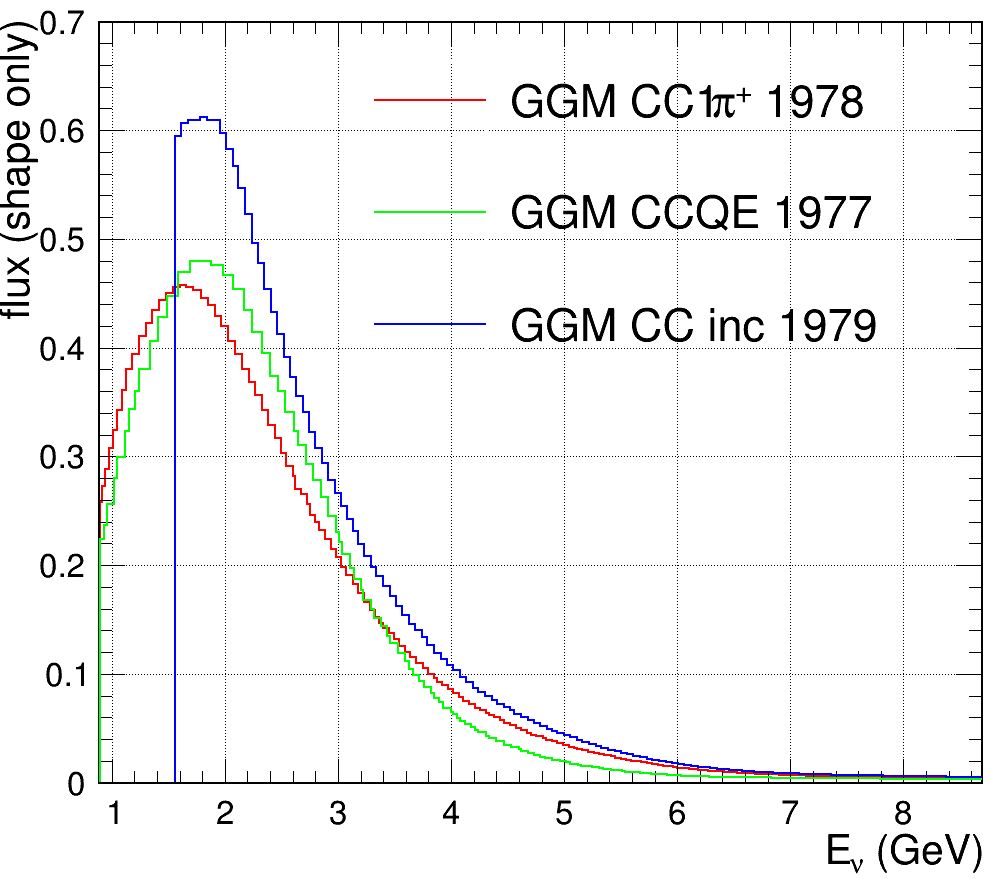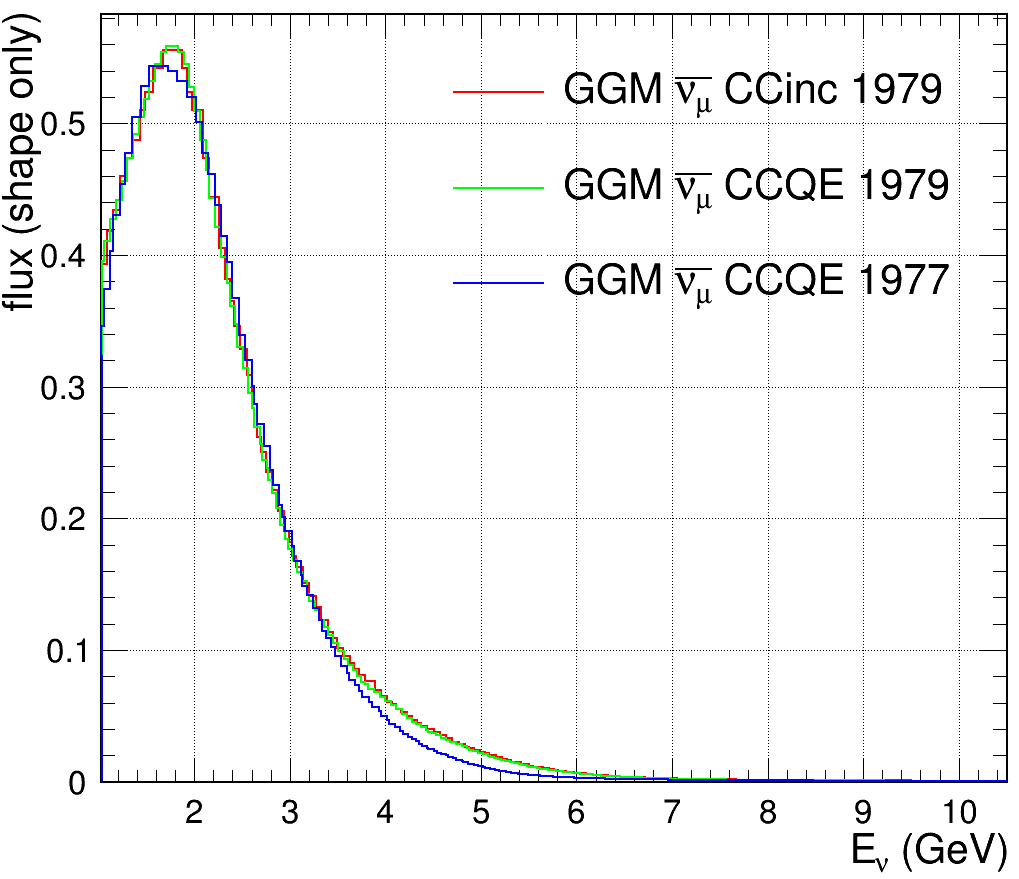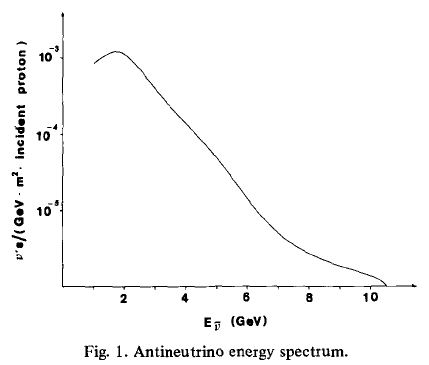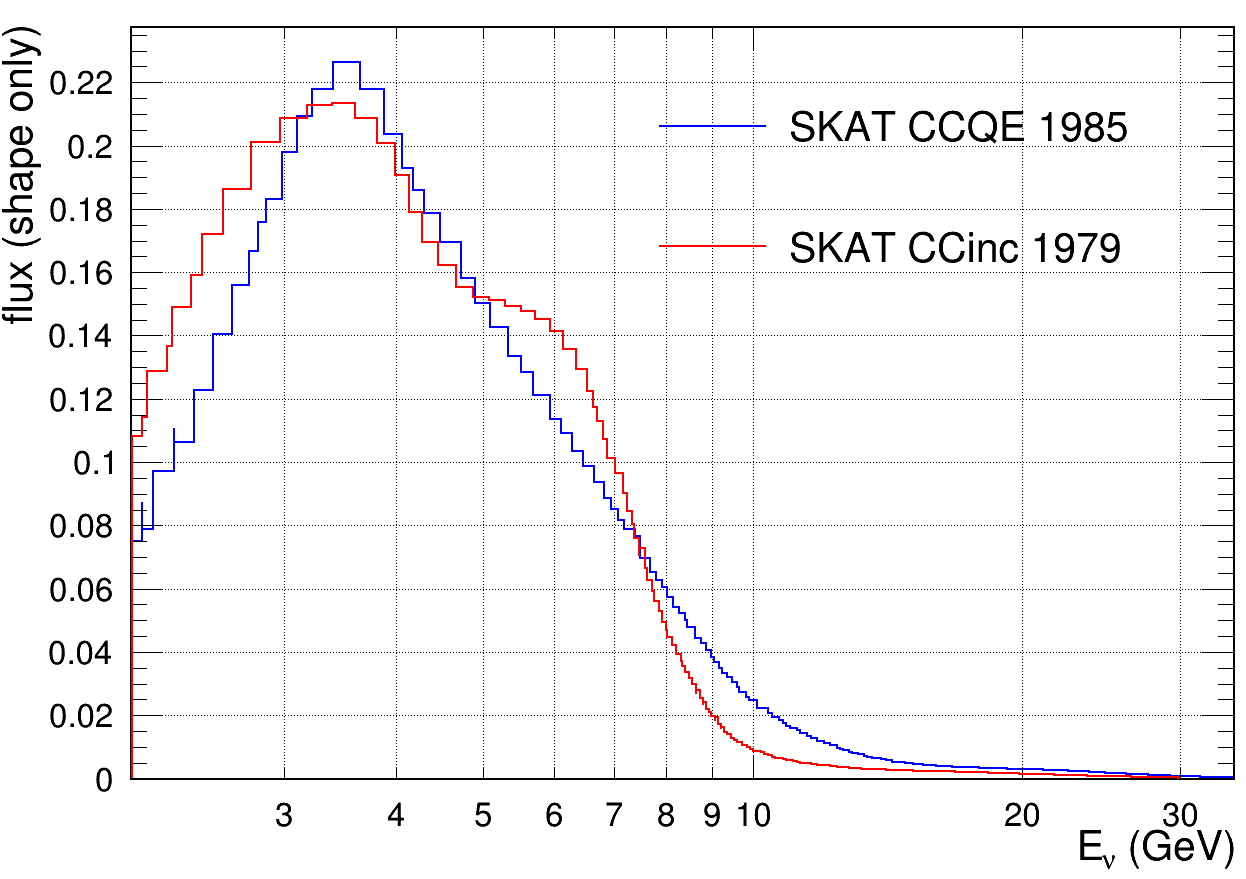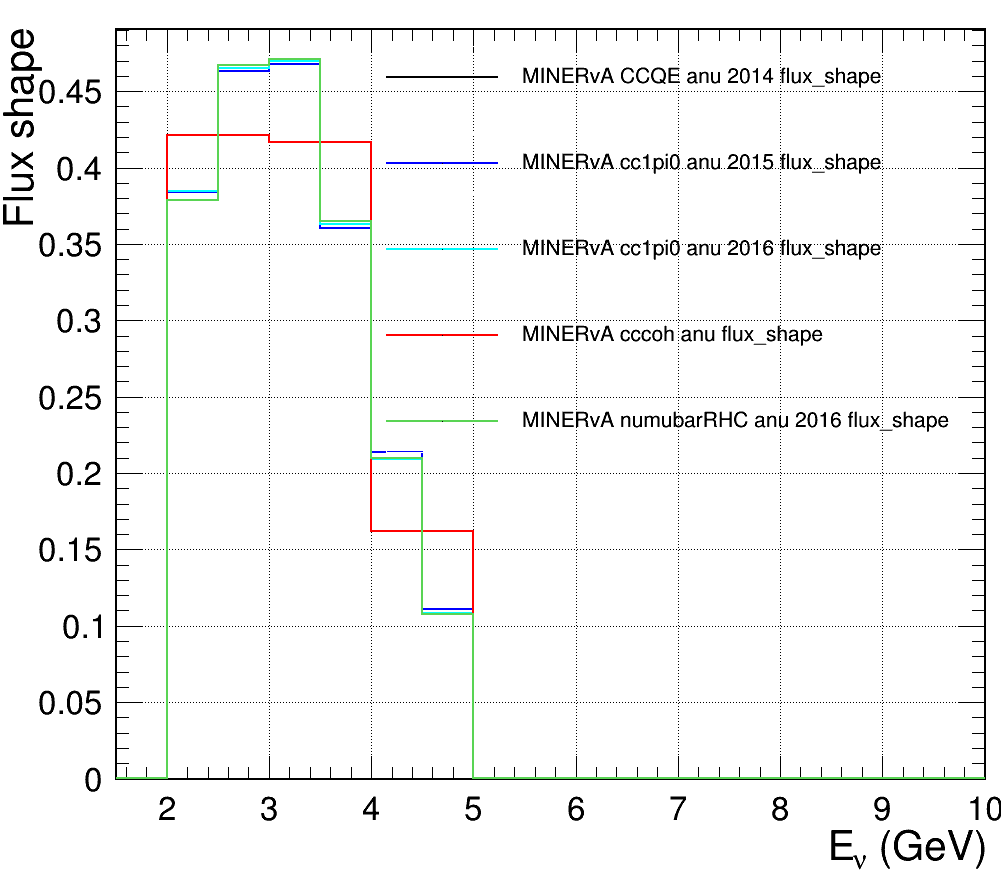| Version 96 (modified by , 9 years ago) (diff) |
|---|
Fluxes
A wikipage to list the experiment fluxes and where to find them in papers
Comments and word of caution: flux simulation is hard work and it is known that the flux uncertainties from early bubble chamber experiments were under-estimated.
Additionally, some experiments seem to use the "flux" interchangeably with "event rate", which can confuse things further.
Introduction
Some experiments determine fluxes solely by simulating the beamline, target interaction and subsequent meson decays; others add in muon monitors after the target to provide additional flux information; others fit selected events (often CCQE) and assume perfect modelling to go from an event rate to a flux. Many experiments have used all these methods to get realistic flux uncertainties, others haven't. Historical neutrino fluxes should always be taken with a pinch of salt.
Precursor
Beware of experiments using only CCQE events to estimate the neutrino flux: In attempting to resolve the CC1pi+1p cross-section discrepancy between ANL and BNL, Wilkinson and Rodrigues (arXiv:1411.4482v1) corrected the CC1pi+1p cross-section by using the experiments' CC1pi+1p/CCQE ratio and multiplying it by the CCQE cross-section in GENIE. The CC1pi+1p/CCQE ratio should cancel most of the flux uncertainties, and so comparing the (CC1pi+1p/CCQE)*(GENIE CCQE) cross-section to the reported CC1pi+1p cross-section could provide an estimate of how accurate the flux calculation was at the experiment. Note the CC1pi+/CCQE ratio agrees well between ANL and BNL.
W&R found that the BNL total cross-section correction was large compared to ANL. BNL used a MA_CCQE fit to CCQE events to estimate their flux, which assumes an understood CCQE interaction model and an understanding of deuterium effects, whereas ANL seem to have used a more sophisticated simulation and a fit.
Graczyk & Sobczyk (arXiv:0908.2175) and others have resolved the problem in similar ways, often introducing a varying normalisation parameter to the ANL and BNL cross-section distributions separately. Additionally,the normalisation parameters can be correlated between the experiments. This approach does not allow for shape changes in the cross-section, which W&R does.
Bubble chamber experiments
ANL
ANL had two runs in which it took data. A period of 1 horn running, another of 2 horns running. The final publications combine the result from the 1 horn and 2 horn running, but do not provide a joint average flux. ANL made both fluxes available but did not specify how much of the 1 horn flux was used in final analyses. Hence the truth PROBABLY lays somewhere in between the 1 horn and 2 horn fluxes.
Neutrino mode
- J. Campbell et al, Study of the Reaction \nu p \rightarrow mu- pi+ p, Physical Review Letters, Volume 30, Number 8, 19 Februrary 1973, 325
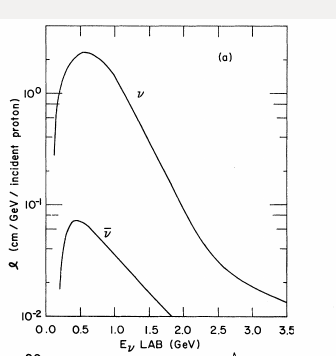
- W. A. Mann et al, Study of the Reaction \nu + n \rightarrow mu- + p, Physical Review Letters, Volume 31, Number 13, 24 September 1973, 844
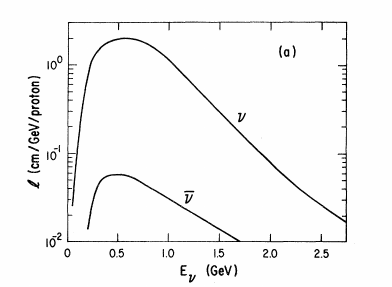
- Barish et al., Study of neutrino interactions in hydrogen and deuterium: Description of the experiment and study of the reaction \nu + d \rightarrow mu- + p + p_s, Physical Review D, Volume 16, Number 11, 1 December 1977, 3103
- Has 1 horn and 2 horn simulations, and shows breakdown by parent meson (e.g. neutrino flux from pion and from kaon)
Anti-neutrino mode
- Haven't found any fluxes yet
BNL
- The BNL flux hard to come by. It is documented in three places; one of which is for a different detector (scintillator), one of which is determined from fitting MA CCQE events for the data-set up to 1981, another which repeats the CCQE fit with the full dataset.
The latter was presented at NuInt02 but was never made public in other than the proceedings. The NuInt02 website is nowadays offline, and the proceedings were to be published in Nucl. Phys. B (Proc. Suppl.), which I have been unable to find. I got my copy through a colleague at KEK instead.
Neutrino mode
- L.A. Ahrens et al, Determination of the neutrino fluxes in the Brookhaven wide-band beams, Physical Review D, Volume 34, Number 1, 1 July 1986
- This uses a dedicated "flux measuring detector" placed in the AGS. It has different radial extent to the original bubble chamber, so shouldn't be used for the bubble chamber flux.
- The paper claims good data-simulation agreement, which adds credibility to the bubble chamber flux. However, the data presented was scaled by x1.1
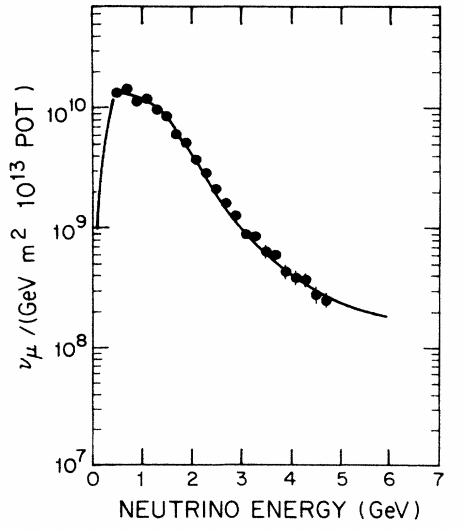
- attachment:BNL_1986_flux.root
- Baker et al., Quasielastic neutrino scattering: A measurement of the weak nucleon axial-vector form factor, Physical Review D, Volume 23, Number 11, 1 June 1981, 2499
- Comes from fitting CCQE events with MA=1.07 with not full data-set
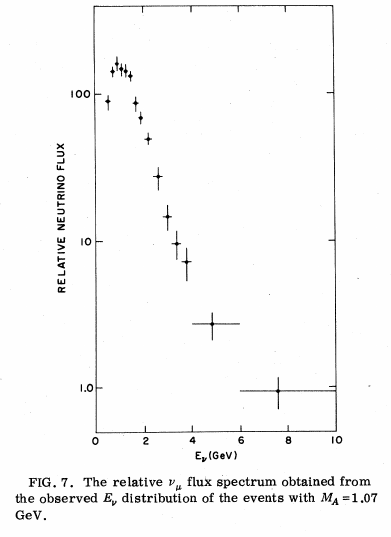
- attachment:BNL_CCQE_1981_rescan.root
- Comes from fitting CCQE events with MA=1.07 with not full data-set
- K. Furuno et al., BNL 7-foot Bubble Chamber Experiment -- Neutrino Deuterium Interactions, Proceedings of the Second International Workshop on Neutrino-Nucleus Interactions in the Few-GeV Region (NuInt02), To be published in Nucl. Phys. B (Proc. Suppl.), December 12-15, 2002, UC Irvine, USA, KEK Preprint 2003-48, September 2003, II
- This is the flux which we use for BNL. It uses CCQE events with double statistics to the above and a fit with MA = 1.1 GeV to determine the incident neutrino flux.
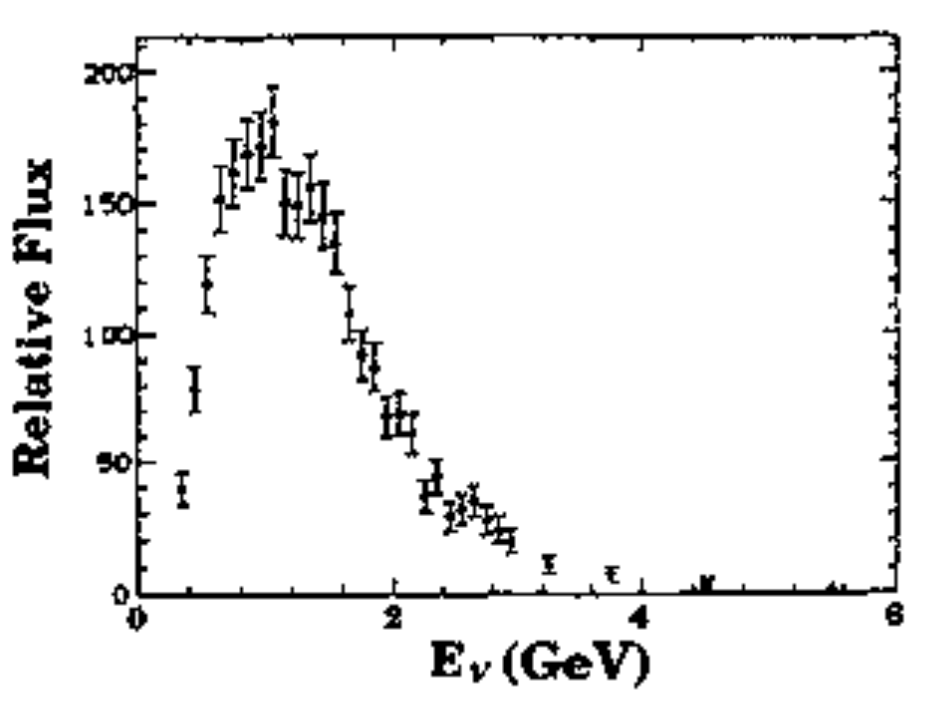
- attachment:BNL_NuInt02_rescan.root
- This is the flux which we use for BNL. It uses CCQE events with double statistics to the above and a fit with MA = 1.1 GeV to determine the incident neutrino flux.
Anti-neutrino mode
- Haven't found this
BEBC
The BEBC fluxes are also difficult to come by. I've only found it in CERN yellow report by H. Wachsmuth. Luckily CERN still maintains these.
I've found no fluxes in any BEBC publications, other than references to Wachsmuth's paper, as well as details on the muon flux by E.H.M Heijne (CERN-83-06, 21 July 1983), and details of the NUBEAM program. I have no found any papers detailing NUBEAM.
Neutrino mode
- H. Wachsmuth, Neutrino and muon fluxes in the CERN 400 GeV proton beam dump experiments, CERN libraries, CERN/EP 79-125, 18 October 1979
- D. Allasia et al, Measurement of the \nu_\mu and \bar{\nu_\mu} nucleon charged-current total cross-sections and the ratio of \nu_\mu neutron to \nu_\mu proton charged-current total cross-sections, Nuclear Physics B, 239, 301-310, 1984, North-Holland Publishing company
- WARNING: THIS IS AN "EVENT RATE", NOT A FLUX
- Identical to below
- S. Barlag PhD thesis, Quasi-elastic interactions and one-pion production by neutrinos and anti-neutrinos on a deuterium target, IAEA.org (haven't found publication) http://www.iaea.org/inis/collection/NCLCollectionStore/_Public/15/069/15069216.pdf, NIKHEF-H
- WARNING: THIS IS AN "EVENT RATE", NOT A FLUX _USE AT RISK_
- Interestingly, there is no y-axis here but the plot is described as an "event energy spectra for the CERB WBB's as measured in this experiment"
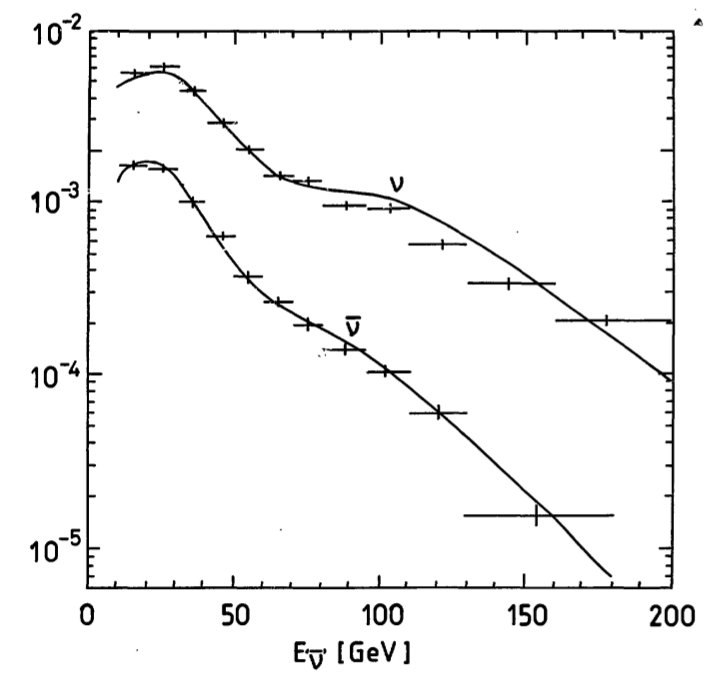
- attachment:BEBC_Barlag_nu_calc_rescan.root
Anti-neutrino mode
- H. Wachsmuth, Neutrino and muon fluxes in the CERN 400 GeV proton beam dump experiments, CERN libraries, CERN/EP 79-125, 18 October 1979
- S. Barlag PhD thesis, Quasi-elastic interactions and one-pion production by neutrinos and anti-neutrinos on a deuterium target, IAEA.org (haven't found publication) http://www.iaea.org/inis/collection/NCLCollectionStore/_Public/15/069/15069216.pdf, NIKHEF-H
FNAL
- Kitagaki et al seems to be the only D2 cross-section paper to place emphasis on the flux estimation.
Neutrino mode
- T. Kitagaki et al, Neutrino Flux and Total Charged-Current Cross Sections in High-Energy Neutrino-Deterium Interactions, Physical Review Letters, Volume 49, Number 2, 12 July 1982, 98
- Protons at 350 GeV/c, unfortunately not always the case (e.g. Barish et al, Phys. Lett 91B, 1, 161, 1980 used 400 GeV/c protons)
- Lists three different methods of getting the neutrino flux
- One is pure simulation (solid line)
- One selects data and derives the flux (points)
- One selectds data to correct the simulation (dashed line)
- Without log y to see how large the data/MC difference was in low energy:
- S. Willocq et al, Coherent production of single pions and \rho mesons in charged-current interactions of neutrinos and antineutrinos on neon nuclei at the Fermilab Tevatron, Physical Review D, Volume 47, Number 7, 1 April 1993, 2661
- For protons of 800 GeV/c, once Fermilab had upgraded to the Tevatron. Listing here for completeness
- attachment:FNAL_coh_1993_nu.root
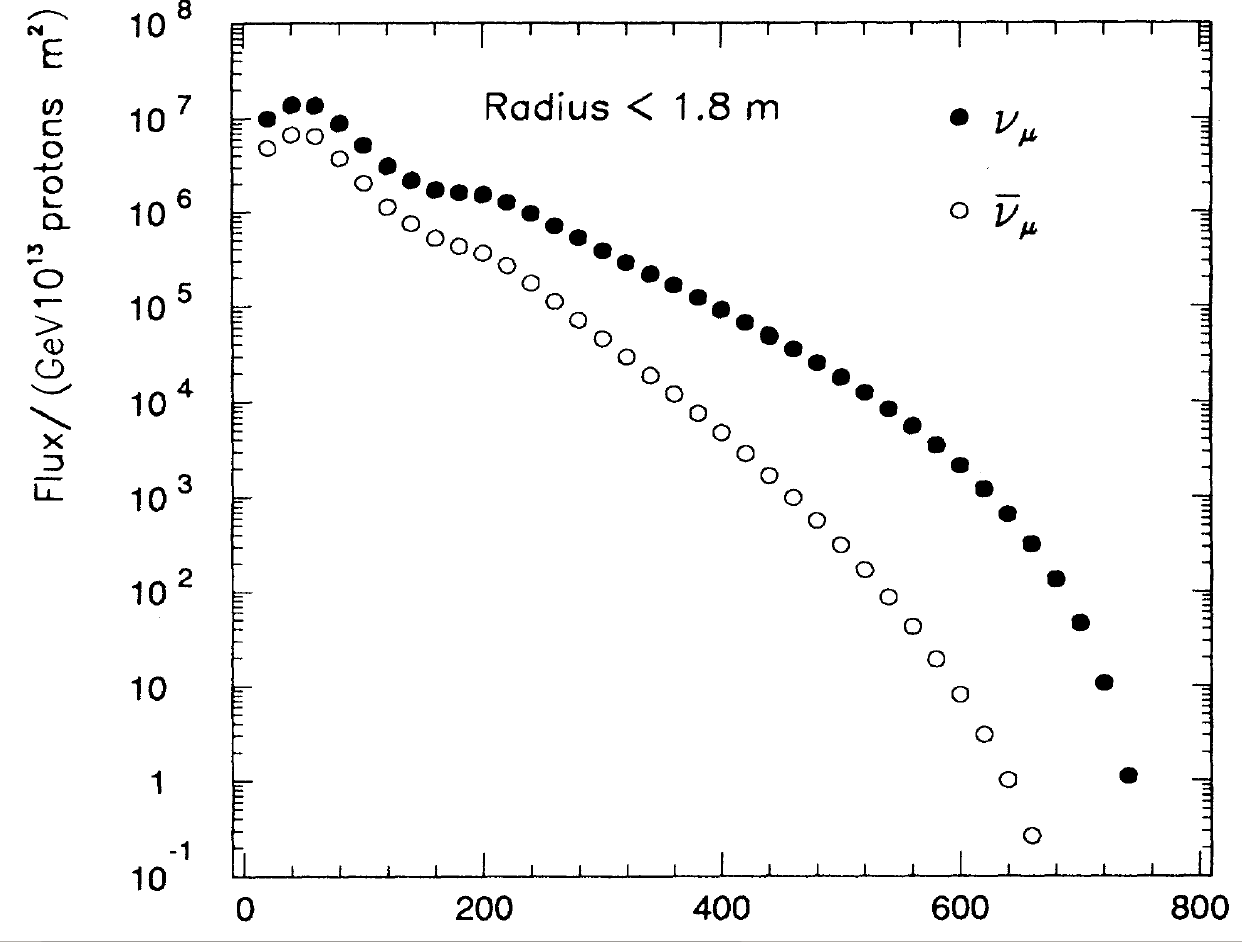
Anti-neutrino
- S. Willocq et al, Coherent production of single pions and \rho mesons in charged-current interactions of neutrinos and antineutrinos on neon nuclei at the Fermilab Tevatron, Physical Review D, Volume 47, Number 7, 1 April 1993, 2661
- See above
- attachment:FNAL_coh_1993_anu.root
Gargamelle
Neutrino
- W. Lerche et al, Experimental study of the reaction \nu p \rightarrow \mu- p \pi+, Physics Letters, Volume 78B, Number 4, 9 October 1978, 510
- S. Ciampolillo et al, Total cross section for neutrino charged current interactions at 3 GeV and 9 GeV, Physics Letters, Volume 84B, Number 2, 18 June 1979, 281
- Is different to above because it cut out certain interactions: set out to determine the total cross-sections at <E>=2.87 GeV and <E>=9.05 GeV
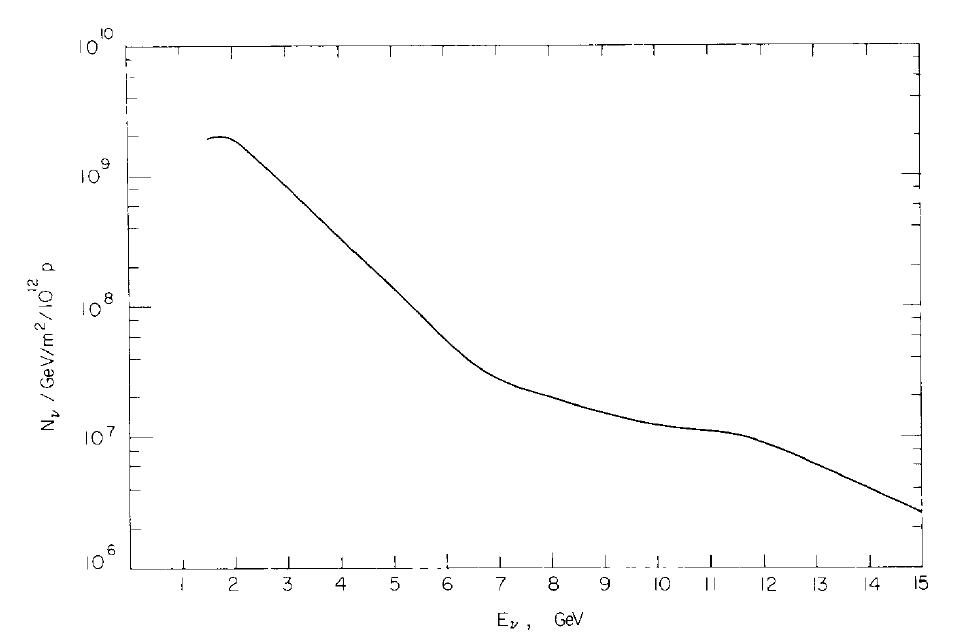
- attachment:GGM_nu_flux_1979_rescan.root
- S. Bonetti et al, Study of Quasi-Elastic Reactions of \nu and \bar{\nu} in Gargamelle, Il Nuovo Cimento, Volume 38A, Number 3, 1 April 1977, 260
- Lacks description of the beam!
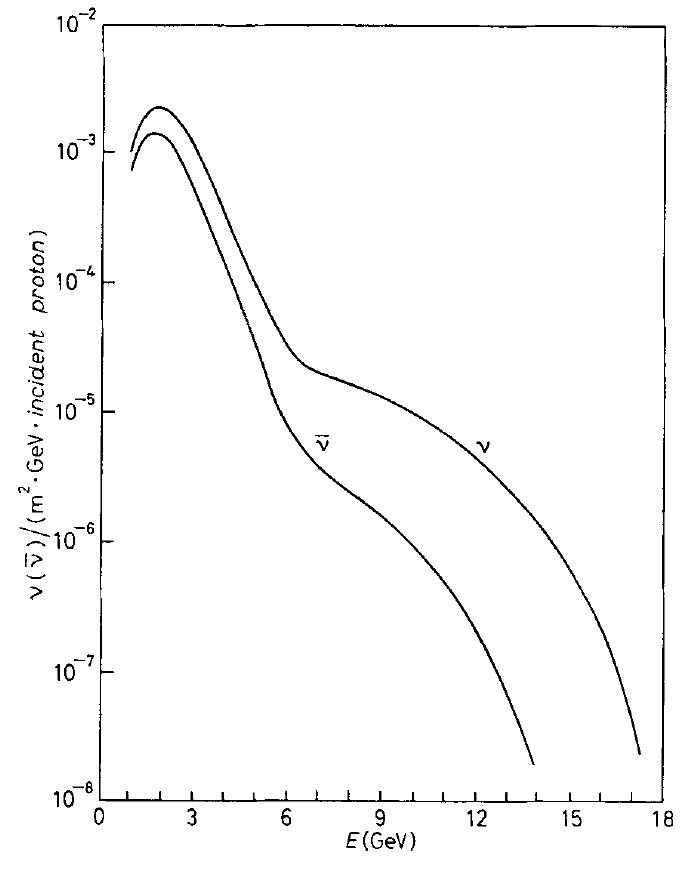
- attachment:GGM_flux_nu_anu_1977_nu_rescan.root
Anti-neutrino
- O. Erriquez et al, Antineutrino-nucleon total cross section and ratio of antineutrino cross section of neutrons and protons, Physics Letters, Volume 80B, Number 3, 1 January 1979, 309
- N. Armenise et al, Charged current elastic antineutrino interactions in propane, Nuclear Physics B152, 365-375, 1979, North-Holland Publishing Company
- Same as above
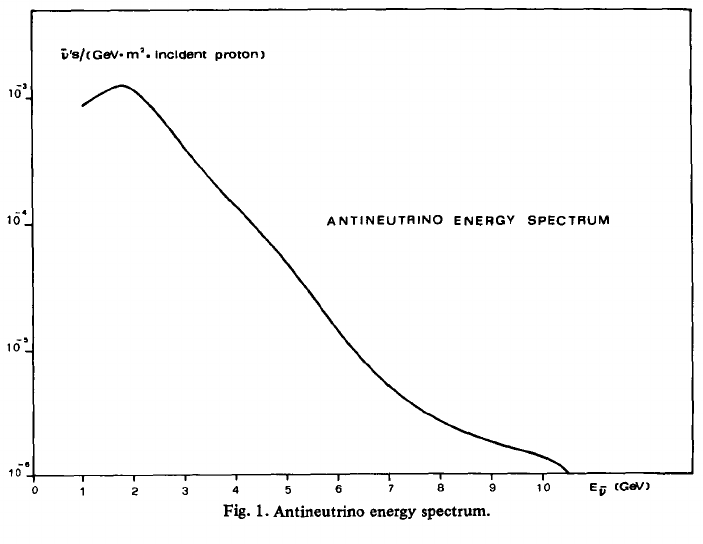
- attachment:GGM_flux_anu_1979_rescan.root
- S. Bonetti et al, Study of Quasi-Elastic Reactions of \nu and \bar{\nu} in Gargamelle, Il Nuovo Cimento, Volume 38A, Number 3, 1 April 1977, 260
- Same as the neutrino-mode reference

- attachment:GGM_flux_anu_CCQE_1979_rescan.root
SKAT
A large portion of the SKAT publications are in Russian and haven't been translated, and the English editions are often rather short.
I've found two fluxes for neutrino-mode which are different. I presume there was a change to the Serpukhov accelerator.
Neutrino
- S.V. Belikov et al, Quasielastic Neutrino and Antineutrino Scattering Total Cross-Sections, Axial-Vector From-Factor, Z. Phys A -- Atoms and Nuclei 320, 625-633 (1985)
- From calculation

- attachment:SKAT_1985_nu_anu_nu_rescan.root
- D.S. Baranov et al, Measurement of the \nu_\muN total cross section at 2--30 GeV in a SKAT neutrino experiment, Physics Letters, Volume 81B, Number 2, 12 February 1979, 255
- From calculation
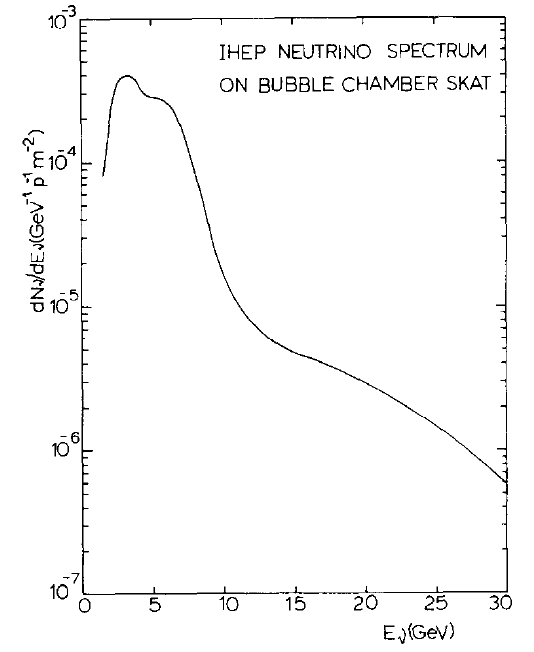
- attachment:SKAT_flux_1979_rescan.root
Anti-neutrino
- S.V. Belikov et al, Quasielastic Neutrino and Antineutrino Scattering Total Cross-Sections, Axial-Vector From-Factor, Z. Phys A -- Atoms and Nuclei 320, 625-633 (1985)
- From calculation, same as neutrino reference

- attachment:SKAT_1985_nu_anu_anu_rescan.root
Nuclear target experiments (2000s+)
MiniBooNE
- The MiniBooNE fluxes are uploaded to the MiniBooNE data release page: http://www-boone.fnal.gov/for_physicists/data_release/flux/
- All MiniBooNE analyses seem to have used the same flux if they were "final analyses"
- A. A. Aguilar-Arevalo et al. (MiniBooNE Collaboration), Neutrino flux prediction at MiniBooNE, Phys. Rev. D 79, 072002, 15 April 2009
- A. A. Aguilar-Arevalo et al, First Measurement of the Muon Neutrino Charged Current Quasielastic Double Differential Cross Section, arxiv:1010.2680v2, 29 July 2010
- A. A. Aguilar-Arevalo et al., Measurement of Neutrino-Induced Charged-Current Charged Pion Production Cross Sections on Mineral Oil at E_\nu ~ 1 GeV, arxiv:1011.3572v2, 31 March 2011
- And probably also in plenty of other papers
SciBooNE
- The SciBooNE flux is uploaded to the SciBooNE data release page: http://www-sciboone.fnal.gov/data_release/flux/
- Y. Nakajuma et al, Measurement of inclusive charged current interactions on carbon in a few-GeV neutrino beam, arxiv:1011.2131v3, 6 January 2011
MINERvA
- MINERvA consistently list fluxes in publications. Sometimes in the paper itself, sometimes in appendices/additionals on arxiv.
- Shape comparison over total range of each flux (some go from 0-10 GeV, others from 1.5-10 GeV, others from 2-6 GeV, so this comparison is not entirely fair!)
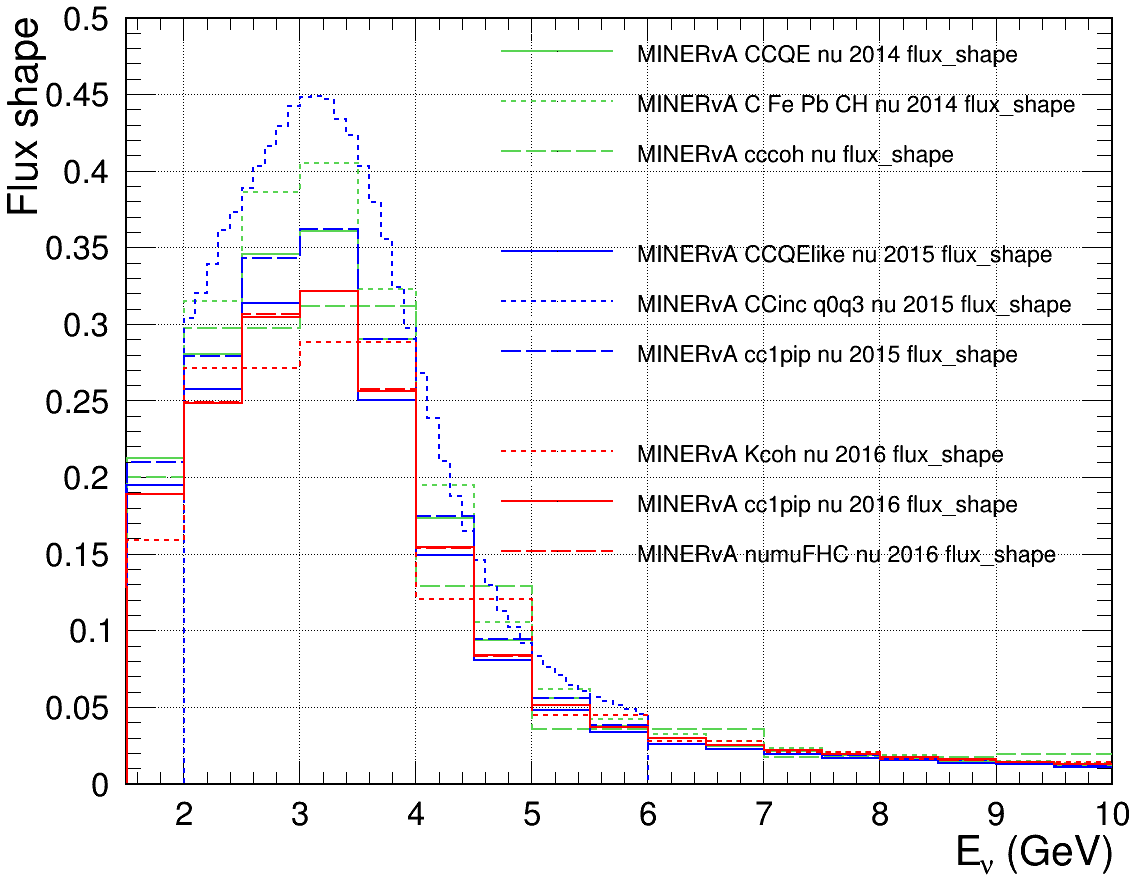
- Shape comparison over limited range of each flux which is always filled (2-6 GeV): this shows all the published fluxes have very similar shape and can be used interchangibly
- The finest binned option is attachment:MINERvA_numuFHC_nu_2016_flux.root
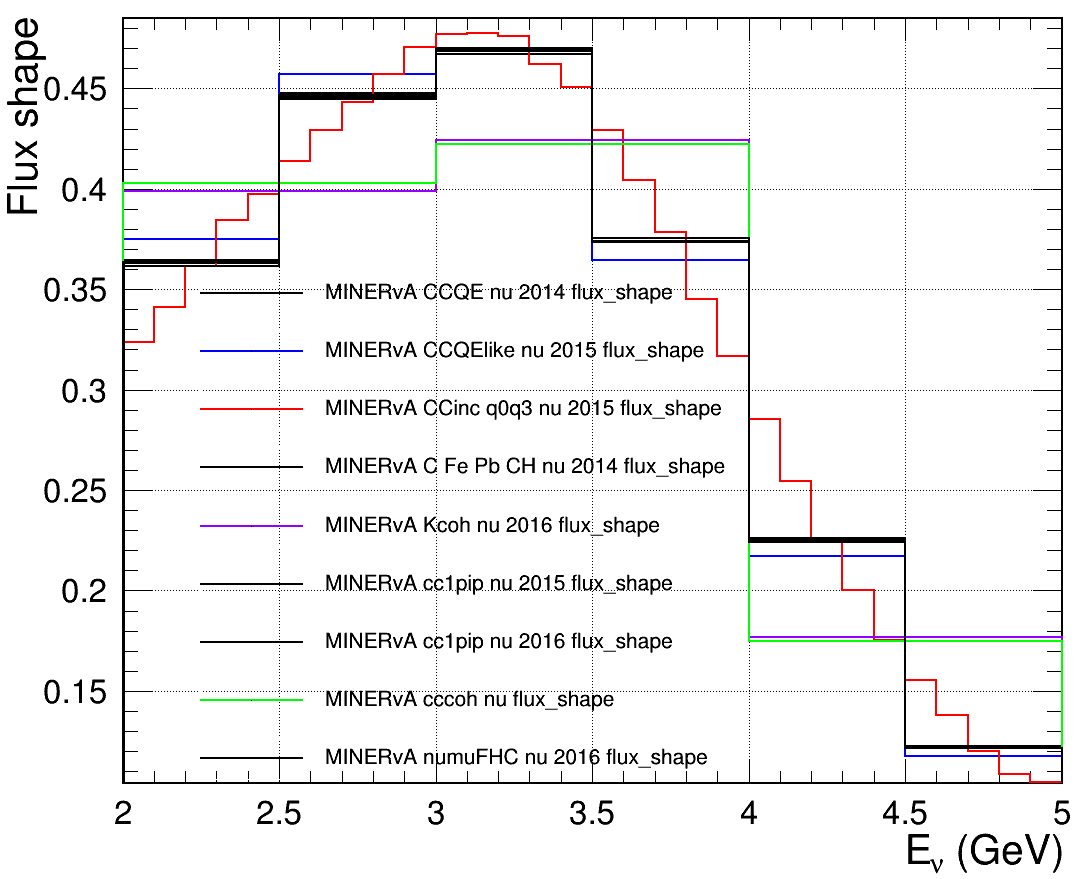
- Note: MINERvA modified the flux after neutrino-electron scattering was measured. It is clear from above that this was mostly a normalisation correction. However, this also means that early MINERvA cross-section data should move its central value by ~11%
Neutrino
CCQE 2014
Target ratios (C Fe Pb CH) 2014
CC coherent 2014
CC1pi+/CCNpi+ 2014/2015
CCinc q0q3 2015
CCQE(like) 2015
K+ coherent 2016
CCNpi+ 2016
Generic NuMI beam 2016
Anti-neutrino
- The same is true for MINERvA anti-neutrino fluxes: there are relatively large normalisation differences in publication to publication
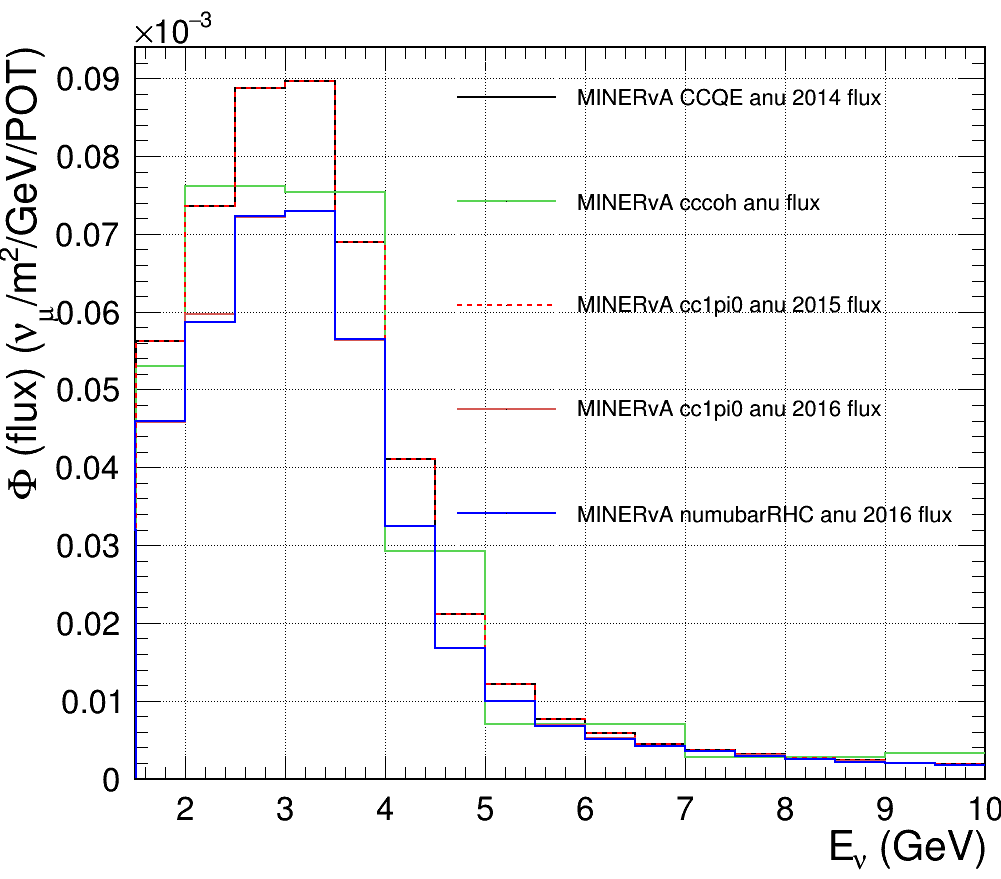
- Same recommendation as previously, use the official NuMI flux attachment:MINERvA_numubarRHC_anu_2016_flux.root
CC coherent anti-neutrino 2013/2014
CCQE anti-neutrino 2014
CC1pi0 anti-neutrino 2015
CC1pi0 anti-neutrino 2016
Generic NuMI beam anti-neutrino 2016
K2K
Neutrino CC1pi+
- A. Rodriguez et al, Measurement of single charged pion production in the charged-current interactions of neutrinos in a 1.3 GeV wide band beam, arxiv:0805.0186v2, 25 June 2008
Neutrino NC1pi0
- S. Nakayama et al, Measurement of single \pi0 production in neutral current neutrino interactions with water by a 1.3 GeV wide band muon neutrino beam, arxiv:hep-ex/0408134v1, 26 Aug 2004
T2K
Attachments (75)
-
ANL_flux_1pi_1973.png (16.9 KB) - added by 9 years ago.
ANL flux from 1pi 1973
-
ANL_flux_CCQE_1973.png (16.5 KB) - added by 9 years ago.
ANL flux from CCQE 1973
-
ANL_flux_CCQE_1horn_1977.png (24.4 KB) - added by 9 years ago.
ANL 1 horn flux from CCQE 1977
-
ANL_flux_CCQE_2horn_1977.png (34.7 KB) - added by 9 years ago.
ANL 2 horn flux from CCQE 1977
- BNL_flux_1986_without_data.png (30.8 KB) - added by 9 years ago.
- BNL_flux_1986.png (47.8 KB) - added by 9 years ago.
- BNL_flux_1981.png (21.8 KB) - added by 9 years ago.
- BNL_flux_NuInt02.png (70.0 KB) - added by 9 years ago.
- BEBC_Wachsmuth_flux_table.png (157.7 KB) - added by 9 years ago.
- BEBC_Wachsmuth_thesis.png (48.7 KB) - added by 9 years ago.
- BEBC_flux_Barlag_thesis.png (75.5 KB) - added by 9 years ago.
- FNAL_flux_1982.png (22.9 KB) - added by 9 years ago.
- FNAL_flux_calc_1993.png (38.4 KB) - added by 9 years ago.
- GGM_flux_1978.png (55.2 KB) - added by 9 years ago.
- GGM_flux_nu_anu_1977.png (16.9 KB) - added by 9 years ago.
- GGM_nu_flux_1979.png (12.8 KB) - added by 9 years ago.
- GGM_flux_anu_1979.png (10.3 KB) - added by 9 years ago.
- GGM_flux_nu_anu_1977.2.png (16.9 KB) - added by 9 years ago.
- GGM_flux_anu_CCQE_1979.png (17.1 KB) - added by 9 years ago.
- SKAT_flux_1979.png (14.0 KB) - added by 9 years ago.
- SKAT_nu_anu_flux_1985.png (20.1 KB) - added by 9 years ago.
- ANL_fluxes_all_on_one.png (22.8 KB) - added by 9 years ago.
- BNL_overlaid.png (29.1 KB) - added by 9 years ago.
- FNAL_CCinc_1982_overlaid.png (33.4 KB) - added by 9 years ago.
- GGM_nu_overlaid.png (34.5 KB) - added by 9 years ago.
- GGM_anu_overlaid.png (34.3 KB) - added by 9 years ago.
- SKAT_nu_overlaid.png (36.9 KB) - added by 9 years ago.
- ANL_1973_CC1pi_rescan.root (6.1 KB) - added by 9 years ago.
- ANL_1973_CCQE_rescan.root (5.6 KB) - added by 9 years ago.
- ANL_1977_1horn_rescan_fine.root (4.9 KB) - added by 9 years ago.
- ANL_1977_2horn_rescan.root (5.4 KB) - added by 9 years ago.
- BEBC_Wachsmuth_numu_table.root (4.0 KB) - added by 9 years ago.
- BEBC_Wachsmuth_numubar_table.root (4.0 KB) - added by 9 years ago.
- BNL_1986_flux.root (5.1 KB) - added by 9 years ago.
- BNL_CCQE_1981_rescan.root (3.9 KB) - added by 9 years ago.
- BNL_NuInt02_rescan.root (4.1 KB) - added by 9 years ago.
- FNAL_CCinc_1982_nu_data.root (3.8 KB) - added by 9 years ago.
- FNAL_CCinc_1982_nu_pureMC.root (5.8 KB) - added by 9 years ago.
- FNAL_CCinc_1982_nu_MCadj.root (5.9 KB) - added by 9 years ago.
- FNAL_coh_1993_anu.root (4.1 KB) - added by 9 years ago.
- FNAL_coh_1993_nu.root (4.1 KB) - added by 9 years ago.
- BEBC_Barlag_anu_calc_rescan.root (5.9 KB) - added by 9 years ago.
- BEBC_Barlag_nu_calc_rescan.root (5.9 KB) - added by 9 years ago.
- GGM_flux_1978_rescan.root (5.4 KB) - added by 9 years ago.
- GGM_flux_anu_1979_rescan.root (5.2 KB) - added by 9 years ago.
- GGM_flux_anu_CCQE_1979_rescan.root (5.7 KB) - added by 9 years ago.
- GGM_flux_nu_anu_1977_anu_rescan.root (6.1 KB) - added by 9 years ago.
- GGM_flux_nu_anu_1977_nu_rescan.root (6.4 KB) - added by 9 years ago.
- GGM_nu_flux_1979_rescan.root (6.0 KB) - added by 9 years ago.
- SKAT_1985_nu_anu_anu_rescan.root (5.9 KB) - added by 9 years ago.
- SKAT_1985_nu_anu_nu_rescan.root (5.6 KB) - added by 9 years ago.
- SKAT_flux_1979_rescan.root (5.7 KB) - added by 9 years ago.
- MINERvA_neutrino_fluxes_shape.png (50.6 KB) - added by 9 years ago.
- MINERvA_neutrino_fluxes.png (45.2 KB) - added by 9 years ago.
- MINERvA_cc1pip_nu_2015_flux.root (4.6 KB) - added by 9 years ago.
- MINERvA_cc1pip_nu_2016_flux.root (4.6 KB) - added by 9 years ago.
- MINERvA_cccoh_nu_flux.root (4.3 KB) - added by 9 years ago.
- MINERvA_CCinc_q0q3_nu_2015_flux.root (5.1 KB) - added by 9 years ago.
- MINERvA_CCQElike_nu_2015_flux.root (4.7 KB) - added by 9 years ago.
- MINERvA_CCQElike_nu_2015_flux.2.root (4.7 KB) - added by 9 years ago.
- MINERvA_CCQE_nu_2014_flux.root (4.6 KB) - added by 9 years ago.
- MINERvA_C_Fe_Pb_CH_nu_2014_flux.root (4.6 KB) - added by 9 years ago.
- MINERvA_Kcoh_nu_2016_flux.root (4.4 KB) - added by 9 years ago.
- MINERvA_neutrino_fluxes_shape_same_range.png (40.0 KB) - added by 9 years ago.
- MINERvA_antineutrino_fluxes_shape.png (35.6 KB) - added by 9 years ago.
- MINERvA_antineutrino_fluxes.png (38.9 KB) - added by 9 years ago.
- MINERvA_cc1pi0_anu_2015_flux.root (4.5 KB) - added by 9 years ago.
- MINERvA_cc1pi0_anu_2016_flux.root (4.5 KB) - added by 9 years ago.
- MINERvA_cccoh_anu_flux.root (4.3 KB) - added by 9 years ago.
- MINERvA_CCQE_anu_2014_flux.root (4.5 KB) - added by 9 years ago.
- MINERvA_numubarRHC_anu_2016_flux.root (4.6 KB) - added by 9 years ago.
- K2K_flux.root (4.0 KB) - added by 9 years ago.
- MINERvA_numuFHC_nu_2016_flux.root (4.5 KB) - added by 9 years ago.
- MINERvA_nueFHC_nue_2016_flux.root (4.5 KB) - added by 9 years ago.
- MINERvA_nuebarRHC_nuebar_2016_flux.root (4.6 KB) - added by 9 years ago.
Download all attachments as: .zip
